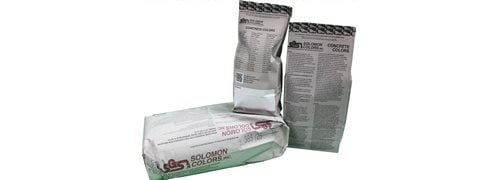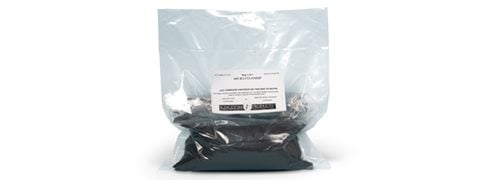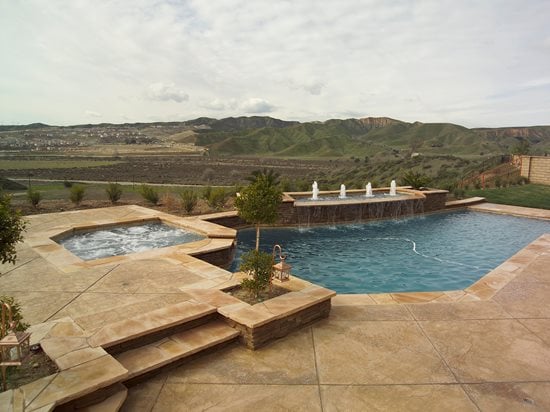- Integral Color Home
- Integral Color vs. Color Hardener for Stamped Concrete
- Tips for Getting the Best Results
- Common Integral Color Issues: Troubleshooting Tips from Expert Chris Sullivan
- Tips for Achieving Consistent Color
- Changing the Color of Integral Concrete
- Related Information:
- Comparison Chart of Concrete Coloring Products
- Product Newsletter Sign Up Today to Receive Monthly Updates
INTEGRAL COLOR CONCRETE PIGMENTS
Get the inside scoop on using integral pigments to color concrete mix, including buying tips and how to achieve the best resultsOne of the most popular methods for coloring newly placed concrete is integral coloring admixtures. These admixtures infuse concrete with rich, long-lasting, fade-resistant color. Stamped concrete contractors often use this coloring medium to produce a backdrop for contrasting accent or antiquing colors, such as pigmented release agents and stains or dyes. This layering of color is what enables them to so closely replicate the variegated, multi-tonal appearance of natural stone.
CONCRETE PIGMENTS IN INTEGRAL COLOR
A concrete pigment is an iron oxide pigment used in integral concrete coloring. They can come in either powder or liquid form. With integral coloring, there are a wide variety of concrete color options available. Many manufacturers offer over 20 standard concrete color additives and custom color matching services. Also, concrete pigments have a low likelihood of fading.
Since the introduction of the repulpable bag, which dissolves when tossed into the concrete mix, using powdered integral coloring has never been easier. Ready Mix suppliers simply toss in the entire bag of color, cutting down on work and mess. Following are product links to integral coloring in repulpable bags:
- Solomon Colors Dry Integral Color
- Butterfield Color DECORATIVE CONCRETE COLORS UNI-MIX® Integral Color
The use of liquid color pigments has also gotten easier since the introduction of concrete color systems. Concrete color systems are PC operated systems designed to help ready mix suppliers use liquid pigments.
Solomon Colors ColorSelect™ Pro Ready-Mix System.
ADVANTAGES OF INTEGRAL COLOR
With integrally colored concrete, the entire batch of concrete is colored all the way through, similar to adding food coloring to cake icing. Integral colors are available in powdered, granular and liquid forms. All types are generally a blend of synthetic or natural iron-oxide pigments that are formulated to disperse evenly when mixed into fresh concrete, either at the ready-mix plant or at the jobsite. The palette for integral pigments consists primarily of soft earth tones that integrate well with most landscapes and architectural elements. (See this color chart for Mix-Ready pigments from Solomon Colors.)
The chief advantage of integral pigments is that the color extends throughout the entire concrete slab, so even if surface abrasion occurs, the color will not wear away. The pigments in integral coloring admixtures also are chemically stable and won't fade over time from exposure to the weather or ultraviolet light.
Another big advantage is convenience and labor savings. Because the integral color is mixed into the concrete, you can simply place and finish the concrete as usual. There's no need to dust the color onto the surface and float it in during finishing, as is the case with shake-on hardeners.
Integrally Colored Concrete Maintenance
INTEGRAL COLOR LIMITATIONS
The main disadvantage of integral color is that the hues are subtle and less intense than what you can achieve with color hardeners. Cost can be another drawback. Because you're coloring the entire batch of concrete rather than just applying color to the surface, you may pay 10% to 30% more for integrally colored concrete than for plain concrete. But generally the cost for labor won't be any higher, since integrally colored concrete is mixed and finished just like conventional concrete.
WHERE TO USE CONCRETE PIGMENTS
Integral pigments can be added to just about any type of new concrete. Popular applications include exterior flatwork, floors, walls and countertops. Integral color is ideal for achieving uniform tones with no variations. It also works well as a contrasting base shade for creating layers of color. For example, stamped concrete contractors often start out with integrally colored concrete and then enhance it with color hardeners, stains and other surface-applied treatments. Indoors, integral color is a good alternative to shake-on color hardeners if mess and cleanup are concerns.
 Solomon Integral Color
Dry and liquid pigments for coloring concrete
Solomon Integral Color
Dry and liquid pigments for coloring concrete
 Butterfield Integral Color
In Repulpable Bags - Toss the Bag Into the Mixer
Butterfield Integral Color
In Repulpable Bags - Toss the Bag Into the Mixer
 Integral Colors - Dry
By Kingdom Products: Suitable for all types of colored concrete
Integral Colors - Dry
By Kingdom Products: Suitable for all types of colored concrete
CHECKLIST FOR INTEGRALLY COLORED CONCRETE FLATWORK
- Verify that no calcium chloride or other incompatible admixture will be used in the mix.
- Pour a sample to make sure the color meets the designer and owner's specifications (different finishing textures can change the look of the concrete)
- Order concrete with substantial lead times as not all colors are kept in stock at all times
- Avoid delays in placement or excessive mixing at the job site
- Check that the type and brand of cement, the aggregate source, and the coloring agent will not change during the job
- Keep the water content and slump consistent from load to load
- Verify the color matching curing or clear cure is available for the selected color-conditioning admixture
- Ponding, fogging, and wet coverings such as burlap should not be used on colored concrete
- Protect colored concrete from damage from construction traffic
WHAT TO CONSIDER BEFORE BUYING COLORING PIGMENTS
-
Only use products that meet or exceed ASTM C 979 standards for pigments for integrally colored concrete. You can usually find this information on the technical data sheet for the product.
-
Most integral pigments on the market today are made from synthetic rather than natural iron oxides. While you can still buy the natural form, synthetics offer two to three times the tinting strength, says technical expert Chris Sullivan.
-
When it comes to powdered versus liquid forms of integral color, one is really no better than the other, according to Sullivan. "They are really the same product and offer the same tinting strength. One just happens to be suspended in water," he says. A downside of liquid pigments is that you'll end up paying more because they contain 30 to 40 percent water. "One pound of dry pigment equals 1.3 to 1.4 pounds of liquid pigment,' he says. Liquid pigments may offer advantages during mixing, however, because they are less messy to handle than bulk powders and they blend in faster. They also can be dispensed with computer-controlled metering systems, which some ready-mix producers use in their plants for more precise dosing and to simplify the blending of custom concrete colors.
-
Ask your ready-mix producer or integral color supplier about the effects other admixtures could have on the workability, set times, and color consistency of integrally colored concrete. Manufacturers say that most admixtures have no detrimental effects on colored concrete, with the exception of calcium-chloride-based accelerators, which can cause discoloration and blotchiness. Some admixtures, however, may shift the color slightly lighter or darker.
-
Because the dosage rate of integral color is based on the cement content of the concrete, some manufacturers warn against using cement substitutes, such as pozzolans and fly ash, because the final color could be affected.
-
In addition to straight integral pigments, you can find "engineered" integral colors that contain admixtures such as water reducers, set retarders, and conditioners. These products are designed to improve the finishability of the colored concrete. Examples include Chromix Admixtures from L.M. Scofield.
-
If you plan to add the integral color to the concrete mix yourself, be sure to consult with the color supplier for guidance on the proper dosage per sack of cement and the required mixing times. Most suppliers offer dry pigments in disintegrating bags of various sizes, ranging from 1 to 25 pounds or more, so you can buy the exact quantity needed for a particular project.
-
Ready-mix producers generally use integral color from one supplier, which may limit your options somewhat. However, Sullivan says that shouldn't be a big concern because the integral colors from the various manufacturers are chemically similar and there's a lot of overlap in color options. "What it comes down to is service and availability," he emphasizes.
Find Local Suppliers: Decorative Concrete Stores
HOW TO FIX INTEGRAL COLOR
Changing the Color of Integral Colored Concrete
 Coloring Products Comparison
Use this chart to decide between integral color, color hardener, stains and more.
Coloring Products Comparison
Use this chart to decide between integral color, color hardener, stains and more.
 Concrete Color Charts
See color charts for color hardeners, integral color and more.
Concrete Color Charts
See color charts for color hardeners, integral color and more.
 Achieving Consistent Color
Get tips for the best results when using integral color.
Achieving Consistent Color
Get tips for the best results when using integral color.






